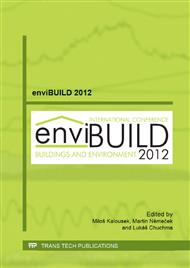p.109
p.113
p.117
p.121
p.125
p.129
p.133
p.139
p.143
The Importance of a Fan Location in the Front Door in Measuring of the Air Permeability by the Blower Door Test
Abstract:
The value of air permeability, or the value of n50 provides important information about the impermeability of the building envelope and thus the quality of internal environment of the building. It is also one of the main evaluation criteria in classifying energy efficient buildings. Air permeability is determined by Blower Door Test where the fan blows air in or out from the measured area. The measurement is performed in a overpressure and afterwards in a underpressure during which the leaks are detected. The frame is usually placed into the front door which themselves is a weak part in the building envelope, and thus the rate of leakage completely denies. The effect of leakage of the front door is so significant that it can often cause a misclassification of the energy efficient buildings. We have tested this hypothesis by Blower Door Test on a passive timber construction build in 2007 during which we have measured the object in position of measuring device placed in the front door and the balcony door that are not encumbered by leaks caused by a security hardware and by other specific elements
Info:
Periodical:
Pages:
125-128
Citation:
Online since:
January 2013
Authors:
Price:
Сopyright:
© 2013 Trans Tech Publications Ltd. All Rights Reserved
Share:
Citation:


